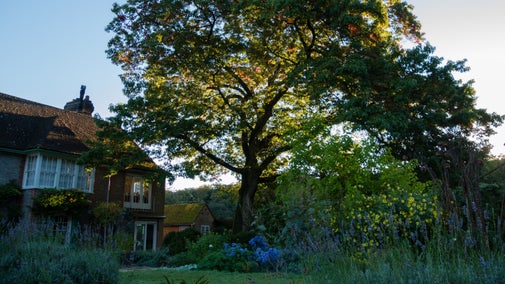
Nuffield Place's collection
Explore the objects and works of art we care for at Nuffield Place on the National Trust Collections website.

Lord Nuffield built the Morris Motor Company from the ground up. He became incredibly successful and celebrated, yet remained a modest man. Alongside his incredible generosity through philanthropy, Lord Nuffield was a complex man who donated to a wide-range of causes, including some seen as controversial. Nuffield Place was his home for the last 30 years of his life – discover his fascinating story.
William Morris was born in October 1877 in Worcester and moved to Oxford with his family at the age of three. At the age of 14 William left school and became an apprentice at an Oxford bicycle shop to help support his family.
After a year, William asked for a pay rise, which was denied, so he promptly set up his own business, a bicycle repair company, with just £4 capital. Morris’ boundless nervous energy and keen business sense saw him make rapid success, and formed the basis for his continued fortunes.
The bicycle repair business was a success, and in 1901 he acquired a shop on Oxford's High Street. He began manufacturing motorcycles in 1903 and before long Morris had set up a garage on Longwall Street, where he started hiring, selling and repairing cars.

A practical man with a passion for engineering, Morris was fascinated by how things were made, and it was a natural move from repairing, hiring and selling cars to manufacturing them. In August 1912 he registered a new company, WRM Motors Ltd, for the manufacturing of motor cars and the first Morris car, the Bullnose, was created the following year.
The contributions made throughout his life by William Morris, later Lord Nuffield, in the fields of motoring, education and health did not go unnoticed and he was awarded several titles.
At the height of Lord Nuffield's career, he was reputedly earning £2,000 a day. However, he was never extravagant with his money. Questioned about his riches, he replied: ‘Well, you can only wear one suit at a time.’ Naturally frugal, Lord Nuffield gave away much of his vast fortune. In total he donated £30 million to good causes, the equivalent of £700 million in today's money.
It has been suggested that Lord Nuffield was a Fascist supporter and anti-semitic, but this does not seem to be supported by the available evidence.
In 1930, Lord Nuffield provided funding for Oswald Mosley to launch ‘The New Party’ with a plan to rebuild Britain’s prosperity after the Wall Street Crash. This party was unsuccessful and Morris did not offer any further support to Mosley. Mosley subsequently went on a European tour which opened his eyes to Fascism and Lord Nuffield did not support Mosley’s British Union of Fascists when it was formed in 1932 or thereafter.
It has been suggested that Lord Nuffield read the nationalist paper The Patriot. On the other hand, his donations book reveals that he privately donated to several Jewish charities.
Lord Nuffield prevented his employees from Unionising in the 1920s and 30s. He argued that the wages he paid were higher than Union rates and he expected fewer hours. In the 1930s his managers introduced new worker benefits such as paid holiday, sick pay and pensions before they were mandatory. During the Second World War, Unions did become established at Lord Nuffield’s factories.

Nuffield Place was Lord Nuffield’s home from 1933 until his death in 1963. Originally named Merrow Mount, the house was designed by Oswald Partridge Milne in 1914 for Sir John Bowring Wimble, a shipping tycoon. When Sir John Wimble died, his widow sold the house to William Morris. Having just been raised to peerage, Morris took his title from the local village and renamed the house. Nuffield Place came into the care of the National Trust in 2012.

Explore the objects and works of art we care for at Nuffield Place on the National Trust Collections website.
We've pulled together all of the information you need to help you make the most of your visit to Nuffield Place.

Explore the house at Nuffield Place. Lord Nuffield's beloved home remains just as it was left, from the wireless to his hidden tool cupboard. Join a morning guided experience or explore at your own pace in the afternoon.

Discover what to see in the garden at Nuffield Place. Explore the winding paths of the Arts and Crafts garden at Lord Nuffield's former home.

Find out how the team at Nuffield Place has worked to recapture how the garden would have looked in the 1950s when Lord and Lady Nuffield lived here.

Discover why Nuffield Place in Oxfordshire has switched to renewable energy and the technology behind the move.

Learn about people from the past, discover remarkable works of art and brush up on your knowledge of architecture and gardens.
